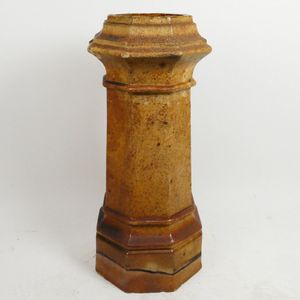Octagonal Colonial Salt Glazed Chimney Pot
A colonial salt glazed chimney pot, of octagonal section raised from a stepped conforming base and with a spreading capital with a stepped reduced mouth.
You must be a subscriber, and be logged in to view price and dealer details.
Subscribe Now to view actual auction price for this item
When you subscribe, you have the option of setting the currency in which to display prices to $Au, $US, $NZ or Stg.
This item has been sold, and the description, image and price are for reference purposes only.
- Capital - In architecture, a capital is the topmost member of a column, pilaster, or pier, which sits on top of the shaft and supports the entablature or architrave above it. The capital is typically the most ornate and decorative element of the column, and it can take many different forms depending on the architectural style of the building.
In classical architecture, the most common types of capitals are the Doric, Ionic, and Corinthian. Doric capitals are simple and have a circular shape with a flat top and bottom. Ionic capitals have a more elaborate design with scrolls or volutes (spiral shapes) at the top, and Corinthian capitals are the most decorative, with elaborate carvings of acanthus leaves and other motifs.
In other architectural styles, capitals can take many different forms, such as the bell-shaped capitals of Gothic architecture or the foliate designs of the Romanesque period. The capital is one of the most important architectural element in a building, it is the one that gives the most character and identity to the building. - Salt Glazed - Salt glazing involves throwing salt into the kiln when it is at its highest temperature, usually around 2,300 to 2,400 degrees Fahrenheit (1,260 to 1,320 degrees Celsius). The salt vaporizes and forms a glaze on the surface of the pottery, creating a range of effects depending on how the salt is applied and the firing conditions. This glazing method was first developed in Germany in the 15th century and quickly became popular throughout Europe and North America. It was particularly popular for making stoneware pottery, such as jugs, crocks, and other utilitarian objects.
Salt glazes can produce a range of colors, including gray, brown, blue, and even pink or purple in some cases. The texture of the glaze is typically rough and pebbled, with a matte or satin finish. The process of salt glazing can be unpredictable, with variations in temperature and salt application leading to subtle variations in the finished product.
Salt glazing is still used by potters and ceramic artists although it is less common than it was in the past.
This item has been included into following indexes:
Visually similar items

Lithgow Pottery chimney pot. Tapering octagonal form with salt glaze. Full kangaroo stamp, height 70 cm
Sold by
in
for
You can display prices in $Au, $US, $NZ or Stg.

A pair of green marble fluted pedestals, late 19th early 20th century, 103 cm high
Sold by
in
for
You can display prices in $Au, $US, $NZ or Stg.

A small rouge marble column, in the grand tour style, 19th century, 44.5 cm high
Sold by
in
for
You can display prices in $Au, $US, $NZ or Stg.

Pedestal: French 19th century rouge marble with fine bronze capitals. Height 106 cm
Sold by
in
for
You can display prices in $Au, $US, $NZ or Stg.
